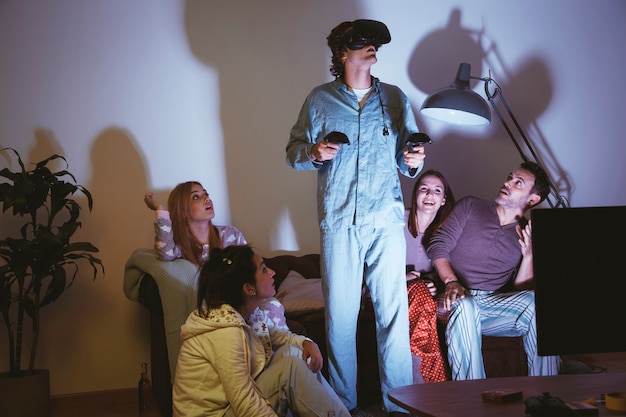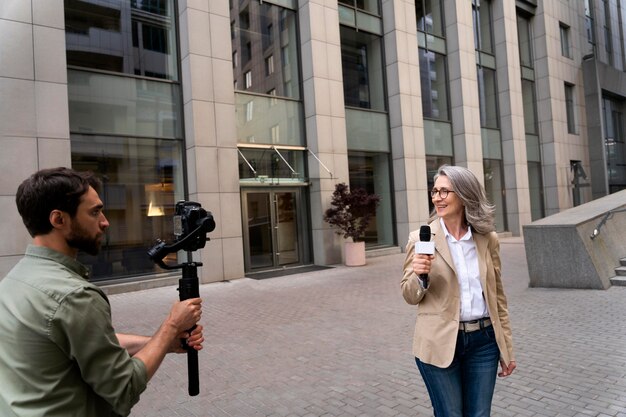The Museum of Broadcast Communications, located in Chicago, is a historical treasure dedicated to the preservation of radio and television broadcasting. Founded in 1982 by Bruce DuMont, this esteemed museum aims to educate and entertain visitors through its vast collection of exhibits and archives. It stands as one of the premier destinations in the United States for anyone interested in the rich history of broadcasting.
Key Takeaways:
- The Museum of Broadcast Communications in Chicago is a must-visit for enthusiasts of radio and television history.
- Founded in 1982 by Bruce DuMont, the museum is dedicated to preserving and showcasing the historical significance of broadcasting.
- Visitors can explore a wide range of exhibits and archives that document the evolution of broadcasting.
- The museum houses the Radio Hall of Fame, which recognizes the accomplishments of influential personalities in the broadcasting industry.
- Located at 360 N. State St, Chicago, the museum offers a fascinating experience for individuals of all ages.
A Hub of Broadcasting History

The Museum of Broadcast Communications serves as a hub for broadcasting history, offering educational programs, exhibits, and archives. The museum’s mission is to educate, inform, and entertain the public while promoting media literacy.
Through its collection of artifacts and archival materials, the museum showcases the evolution of broadcasting over the years. Visitors can explore a wide range of exhibits that highlight the impact of radio and television on society and culture.
Whether you’re interested in the early days of radio, the golden age of television, or the latest innovations in digital media, the Museum of Broadcast Communications is a must-visit destination for anyone curious about the history of broadcasting.
Table: Highlights of the Museum of Broadcast Communications
| Exhibits | Archives | Educational Programming |
|---|---|---|
| Award-winning exhibits showcasing broadcasting history | Over 85,000 hours of radio and television broadcasts | Workshops, lectures, and interactive programs for all ages |
| Interactive displays and multimedia presentations | Archival materials, including original ventriloquist puppets and historic television cameras | Media literacy workshops to help visitors understand the impact of broadcasting |
| Special exhibits dedicated to iconic personalities and shows | Oprah’s famous entrance door and other iconic artifacts | Hands-on activities to engage visitors in the world of broadcasting |
Whether you’re a broadcasting enthusiast, a history buff, or simply looking for an educational and entertaining experience, the Museum of Broadcast Communications has something for you. Plan your visit today and discover the fascinating world of broadcasting history.
Radio Hall of Fame
The Museum of Broadcast Communications is proud to house the esteemed Radio Hall of Fame, which honors the exceptional accomplishments of personalities in the field of radio and television. This prestigious institution recognizes the enduring impact of individuals who have shaped the broadcasting industry. From legendary DJs to talk show hosts and news anchors, the Radio Hall of Fame celebrates the diverse range of talents and contributions made by these influential figures.
In the Radio Hall of Fame, visitors can explore exhibits that highlight the achievements and innovations of radio broadcasters throughout history. This includes the pioneers who revolutionized the medium, as well as the trailblazers who brought rock & roll and other genres to the airwaves. The museum’s interactive displays and engaging multimedia presentations offer an immersive experience, allowing visitors to dive deep into the world of radio and television broadcasting.
One of the remarkable aspects of the Radio Hall of Fame is its recognition of individuals who have left a profound mark not only in the radio industry, but also in the realm of television. This acknowledges the interconnectedness of these two mediums and the significant influence that radio personalities have had on the development of television programming. The Radio Hall of Fame serves as a lasting testament to the power of radio and its enduring impact on popular culture.
| Inductee | Year Inducted | Contribution |
|---|---|---|
| Orson Welles | 1988 | Renowned actor, director, and radio producer known for the infamous “War of the Worlds” broadcast. |
| Chuck Berry | 1989 | Legendary musician and singer-songwriter who popularized rock & roll on the radio. |
| Oprah Winfrey | 2011 | Iconic talk show host and media mogul who revolutionized daytime television. |
| David Letterman | 2012 | Beloved late-night talk show host known for his unique comedic style and memorable interviews. |
Through the Radio Hall of Fame, visitors can gain a deeper appreciation for the impact of radio and television broadcasting on society and culture. It’s a tribute to the individuals who have shaped the industry and a reminder of the enduring power of the airwaves.
Chicago Television Gallery

The Museum of Broadcast Communications houses the Chicago Television Gallery, a dedicated space that celebrates iconic television personalities and shows that have left a lasting mark on the city. This gallery showcases exhibits dedicated to beloved characters like Bozo, Svengoolie, and Garfield Goose, evoking nostalgia and fond memories of classic television.
One of the highlights of the Chicago Television Gallery is the interactive Bozo exhibit, which allows visitors to step into the world of the beloved clown and experience the magic of his show. From watching vintage clips to trying on a replica Bozo wig, this exhibit offers an immersive journey into the history of one of Chicago’s most iconic television programs.
In addition to Bozo, visitors can also explore exhibits dedicated to Svengoolie, the beloved horror show host known for his wit and charm, and Garfield Goose, a puppet character who entertained generations of Chicagoans with his whimsical adventures. These exhibits feature artifacts, memorabilia, and behind-the-scenes stories that showcase the impact these personalities had on the city’s television landscape.
Also Read:- Explore America’s Top Broadcast Network For Quality TV Shows
The Chicago Television Gallery at the Museum of Broadcast Communications is a must-visit for anyone interested in the rich history of television in Chicago. Whether you grew up watching these iconic shows or are simply curious about the city’s broadcasting heritage, this gallery offers a unique and engaging experience that will transport you back in time.
| Exhibit | Description |
|---|---|
| Bozo | An interactive exhibit dedicated to the iconic clown, featuring clips, memorabilia, and a chance to try on a replica Bozo wig. |
| Svengoolie | An exhibit exploring the horror show host’s impact on Chicago television, with artifacts, behind-the-scenes stories, and classic clips. |
| Garfield Goose | A tribute to the popular puppet character, showcasing his whimsical adventures, puppets, and memorable moments from the show. |
Archives and Artifacts

The Museum of Broadcast Communications boasts an extensive collection of archival materials and artifacts that offer a glimpse into the rich history of broadcasting. With over 85,000 hours of radio and television broadcasts, the museum’s archives provide a comprehensive resource for researchers, historians, and enthusiasts alike. From vintage recordings to iconic props, the artifacts on display showcase the evolution of broadcasting and its impact on society.
Visitors to the museum can explore a variety of exhibits that highlight different aspects of broadcasting history. Step back in time as you view original ventriloquist puppets used in early television shows or get a behind-the-scenes look at historic television cameras. Immerse yourself in the world of radio broadcasting through a collection of vintage microphones and broadcasting equipment.
The museum’s archives also house unique items that have become iconic symbols of broadcasting history. Marvel at Oprah’s famous entrance door, which holds a special place in the hearts of her fans. Delve into the world of television programming as you discover original scripts, promotional materials, and memorabilia from beloved shows of the past.
| Artifacts | Description |
|---|---|
| Ventriloquist Puppets | Original puppets used in early television shows, showcasing the artistry and creativity of performers. |
| Vintage Microphones | A collection of classic microphones used in radio broadcasting, representing the evolution of audio technology. |
| Television Cameras | Historic cameras that captured the early days of television, showcasing the advancements in visual broadcasting. |
| Oprah’s Entrance Door | The iconic door that Oprah Winfrey walked through during her long-running talk show, symbolizing her impact on television and media. |
| Scripts and Memorabilia | Original scripts, promotional materials, and memorabilia from classic television shows that have left a lasting mark on broadcasting history. |
Museum of Broadcast Communications – Visitor Information and Location
The Museum of Broadcast Communications is located in the vibrant city of Chicago, Illinois. Situated at 360 N. State St, the museum is conveniently accessible and easy to find. If you have any questions or need additional information, you can reach out to the museum’s friendly staff at (312) 245-8200. Alternatively, you can visit the museum’s website for more details.
When planning your visit, it’s important to note that the Museum of Broadcast Communications is open from Tuesday to Sunday. The museum offers flexible hours to accommodate different schedules, ensuring that visitors have ample time to explore the exhibits and immerse themselves in the rich history of broadcasting. Whether you’re a fan of radio, television, or both, this museum provides a captivating experience for all.
| Days | Opening Hours |
|---|---|
| Tuesday-Saturday | 10:00 AM – 5:00 PM |
| Sunday | 12:00 PM – 5:00 PM |
Admission to the Museum of Broadcast Communications is reasonably priced, and discounts are available for various groups. Seniors, students, educators, and military personnel can take advantage of reduced rates, making it an affordable outing for everyone. So gather your friends, family, or even plan a solo trip to this unique museum that celebrates the fascinating world of broadcasting.
Don’t miss out on the opportunity to visit the Museum of Broadcast Communications and delve into the captivating history of radio and television. With its convenient location in Chicago, informative exhibits, and affordable admission, it’s an experience that’s both educational and entertaining.
Accommodations and Nearby Attractions
The Museum of Broadcast Communications goes above and beyond to ensure that all visitors have a comfortable experience. The museum offers accommodations for persons with disabilities, including wheelchair accessibility, to ensure everyone can explore the exhibits and enjoy the rich history of broadcasting. Additionally, the museum provides a self-service coat check to store belongings and a gift shop where visitors can find unique souvenirs to commemorate their visit.
While in Chicago, visitors to the Museum of Broadcast Communications can take advantage of the museum’s prime location and explore nearby attractions. One of the must-see attractions is the Chicago Architecture Center, located just a short distance away. Here, visitors can immerse themselves in Chicago’s rich architectural history and learn about iconic structures like the Tribune Tower and the Wrigley Building.
Whether you’re interested in broadcasting history or simply want to explore the vibrant city of Chicago, the Museum of Broadcast Communications is an ideal destination. With its accommodations for persons with disabilities and proximity to other notable attractions, the museum offers a well-rounded experience for all visitors.
Nearby Attractions
In addition to the Chicago Architecture Center, there are several other nearby attractions that visitors can explore during their trip to the Museum of Broadcast Communications. Here are a few recommendations:
- Millennium Park: A beautiful park featuring public art installations, gardens, and the famous Cloud Gate sculpture, also known as “The Bean.”
- Art Institute of Chicago: One of the oldest and largest art museums in the United States, housing a world-renowned collection of artworks.
- The Magnificent Mile: A prestigious shopping district on Michigan Avenue, known for its luxury brands, department stores, and iconic landmarks.
- Navy Pier: A popular tourist spot offering entertainment, dining, and stunning views of Lake Michigan.
- Field Museum: A natural history museum that houses an extensive collection of artifacts, including Sue, the largest and most complete T. rex skeleton.
With these nearby attractions, visitors to the Museum of Broadcast Communications can extend their stay in Chicago and explore the city’s cultural, artistic, and natural wonders.
| Attraction | Description |
|---|---|
| Chicago Architecture Center | Offers insight into the city’s architectural history and landmarks, including the Tribune Tower and Wrigley Building. |
| Millennium Park | A beautiful urban park with art installations, gardens, and the famous Cloud Gate sculpture. |
| Art Institute of Chicago | One of the oldest and largest art museums in the United States, with a diverse collection spanning centuries and cultures. |
| The Magnificent Mile | A prestigious shopping district known for its luxury brands, department stores, and iconic landmarks. |
| Navy Pier | A popular waterfront destination with entertainment, dining, and panoramic views of Lake Michigan. |
| Field Museum | A natural history museum housing an extensive collection of artifacts, including the famous T. rex skeleton, Sue. |
Plan Your Visit
When planning your visit to the Museum of Broadcast Communications, there are a few important details to keep in mind. The museum is open from Thursday to Sunday, with specific opening hours listed on their website. It’s always a good idea to check the website or call ahead to confirm the operating hours before you go.
The Museum of Broadcast Communications is conveniently located at 360 N. State St, Chicago, IL 60654. Situated in the heart of the city, it’s easily accessible by public transportation or by car. If you’re taking public transit, there are several bus stops and train stations nearby, making it a convenient destination for tourists and locals alike.
Admission prices and facilities information for the museum are not readily available, but you can find more details on their website or by contacting them directly. To get a better sense of the visitor experience, you can also check out reviews of the museum online. Hearing about others’ experiences can provide valuable insights and help you plan your visit accordingly.
With its rich history, engaging exhibits, and dedication to preserving broadcasting artifacts, the Museum of Broadcast Communications is a must-visit destination for anyone interested in the medium’s past. Whether you’re a fan of radio or television, the museum offers a unique opportunity to explore the evolution of broadcast media and its impact on society.
Conclusion
The Museum of Broadcast Communications in Chicago is a treasure trove of broadcasting history. With its extensive collection of exhibits and archives, the museum brings to life the rich and influential world of radio and television. Visitors can immerse themselves in the evolution of broadcasting, from its early days to the modern era.
From iconic personalities to historical artifacts, the museum showcases the power and impact of broadcast media. It provides a unique opportunity to explore the exhibits and delve into the archives, gaining a deeper understanding of the role that broadcasting has played in shaping our society.
Not only is the museum an educational experience, but it also offers entertainment for visitors of all ages. Whether you have a passion for media literacy or simply enjoy nostalgic television shows, the Museum of Broadcast Communications has something to offer everyone.
So, if you find yourself in Chicago, make sure to visit this captivating museum and discover the fascinating world of broadcasting history.
FAQs
Q: What is the Museum of Broadcast Communications?
A: The Museum of Broadcast Communications is a museum located in Chicago that is dedicated to preserving and showcasing the history of radio and television broadcasting.
Q: When was the Museum of Broadcast Communications founded?
A: The museum was founded in 1982 by Bruce DuMont.
Q: What does the museum aim to do?
A: The museum aims to educate and entertain visitors through its exhibits and archives.
Q: How many museums in the United States are solely focused on broadcast history?
A: The Museum of Broadcast Communications is one of only three museums in the United States solely focused on broadcast history.
Q: What is housed in the Radio Hall of Fame?
A: The Radio Hall of Fame celebrates the accomplishments of personalities who have made a significant impact on both radio and television.
Q: What does the Chicago Television Gallery showcase?
A: The Chicago Television Gallery showcases iconic television personalities and shows that have left a lasting mark on the city.
Q: What is included in the museum’s collection?
A: The museum’s collection includes a wide range of artifacts and programming memorabilia that showcase the evolution of broadcasting over the years.
Q: Where is the Museum of Broadcast Communications located?
A: The museum is located at 360 N. State St, Chicago, IL 60654.
Q: What are the opening hours of the museum?
A: The specific opening hours can be found on the museum’s website.
Q: Are there admission discounts available?
A: Yes, admission discounts are available for seniors, students, educators, and military personnel.
Q: What accommodations are available for persons with disabilities?
A: The museum offers accommodations for persons with disabilities, including wheelchair accessibility.
Q: What nearby attractions can visitors explore?
A: Visitors can explore nearby attractions such as the Chicago Architecture Center, Tribune Tower, and the iconic Wrigley Building.
Q: How can visitors contact the museum?
A: Visitors can contact the museum at (312) 245-8200 or visit their website for more information.
Q: What is the Museum of Broadcast Communications (MBC)?
A: The Museum of Broadcast Communications is a historical institution dedicated to preserving and celebrating the history of broadcast media, including radio and television content.
Q: Where is the Museum of Broadcast Communications located?
A: The MBC is located at 360 N State Street, in the downtown area of Chicago, Illinois.
Q: When was the Museum of Broadcast Communications founded?
A: The Museum of Broadcast Communications was founded in 1982, with the aim of collecting and presenting historic and contemporary artifacts related to the power of broadcast media.
Q: What can visitors expect to find at the Museum of Broadcast Communications?
A: Visitors can explore historical exhibits, the National Radio Hall of Fame, and educational programs that inspire creativity and imagination.
Q: What is the significance of the National Radio Hall of Fame exhibit at the MBC?
A: The National Radio Hall of Fame exhibit at the MBC celebrates the achievements and contributions of notable figures in the history of radio broadcasting.
Q: How does the MBC contribute to educational initiatives?
A: The Museum of Broadcast Communications provides educational programs and curriculum aimed at fostering accountability and creativity in the realm of broadcast media.
Q: What is the new location for the Museum of Broadcast Communications?
A: The MBC recently relocated to the Chicago Cultural Center, with its exhibition space situated on the second floor of the building.
Q: Is the MBC currently open to the public amid the COVID-19 pandemic?
A: The MBC has implemented measures to ensure the safety of visitors and staff, and it is currently open to the public for exploration of its exhibits and programs.
Q: Are there any notable annual events hosted by the Museum of Broadcast Communications?
A: The MBC hosts events such as the June 13 celebration and the induction of new members into the National Radio Hall of Fame, honoring their contributions to the broadcast industry.
Q: How does the Museum of Broadcast Communications honor the legacy of influential figures in broadcast history?
A: The MBC pays tribute to influential figures such as Dumont, Foster, and WGN, recognizing their impact on the evolution of broadcast media through exhibitions and dedicated galleries.


